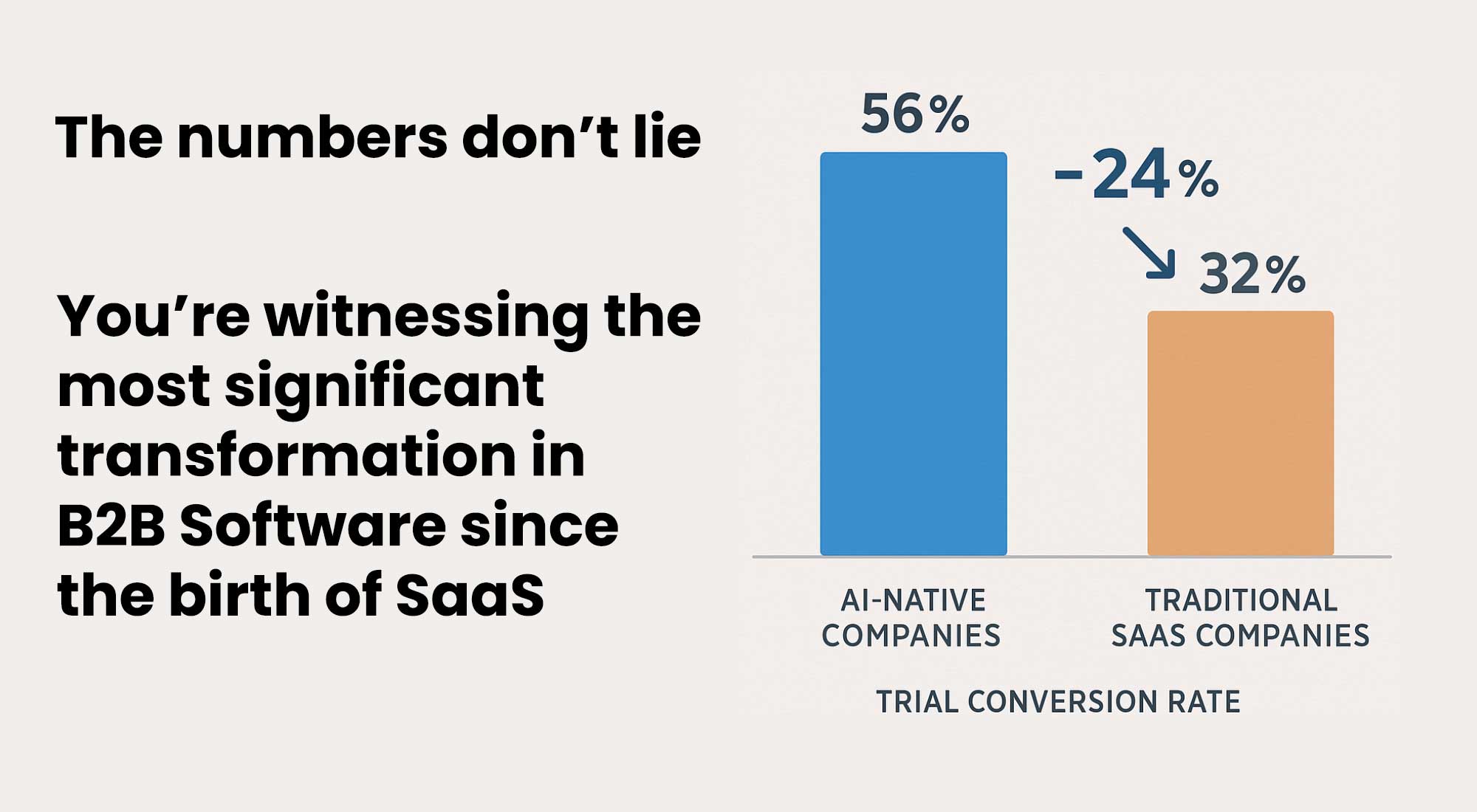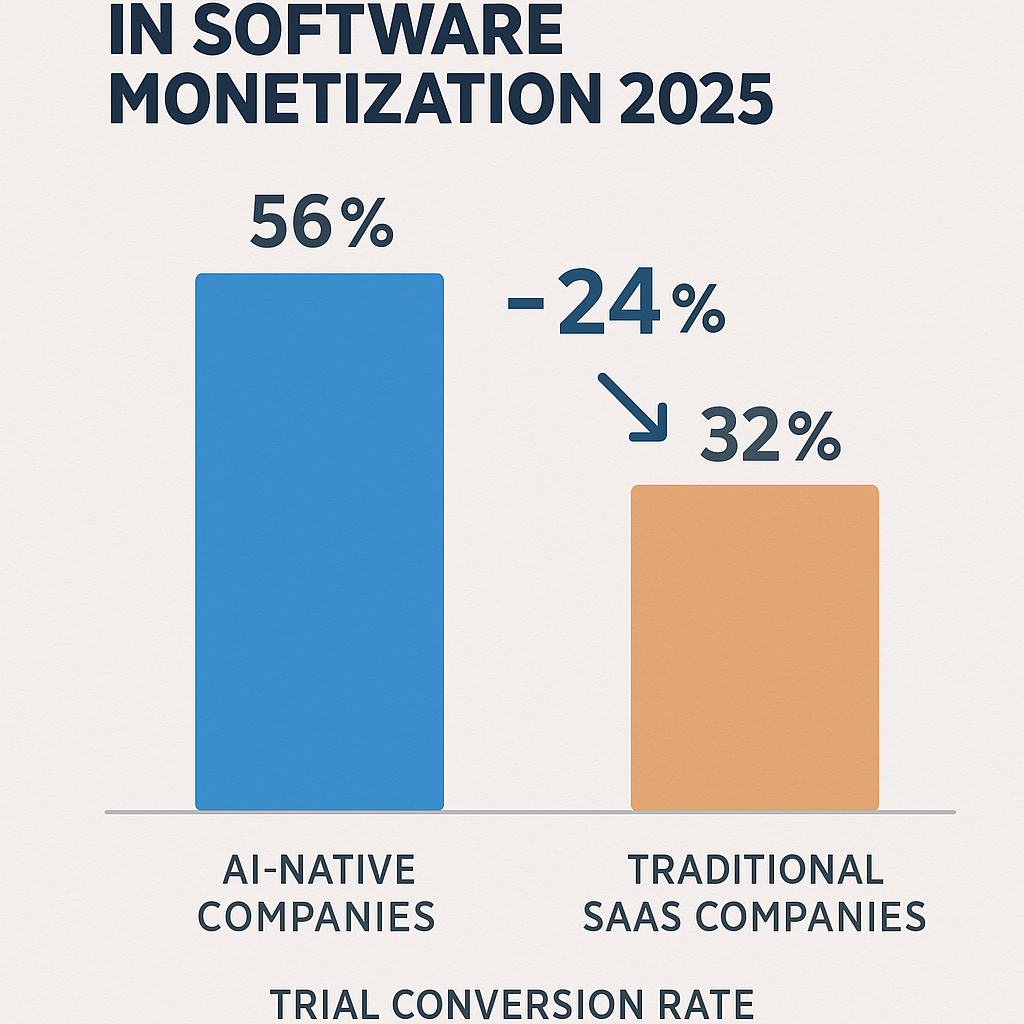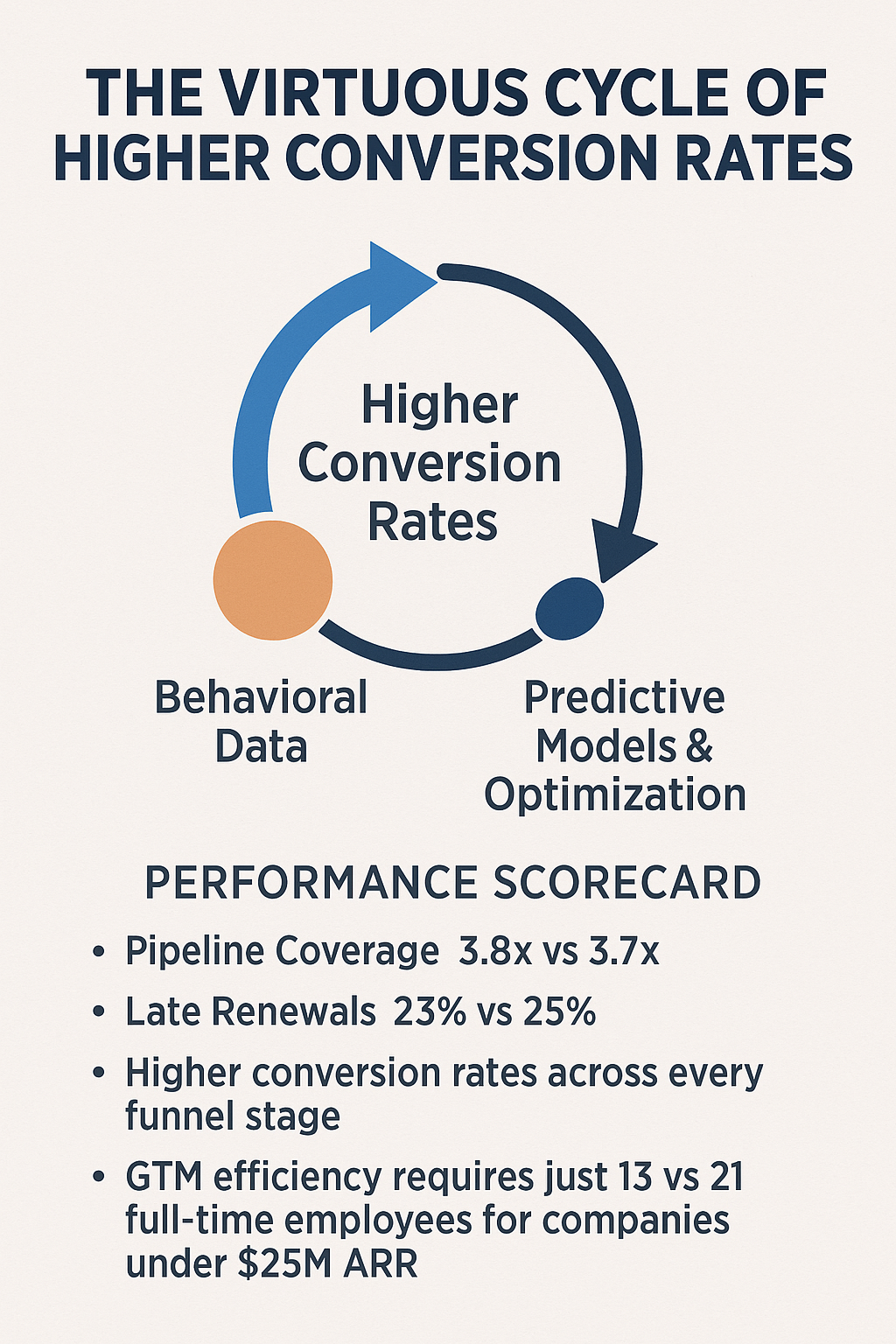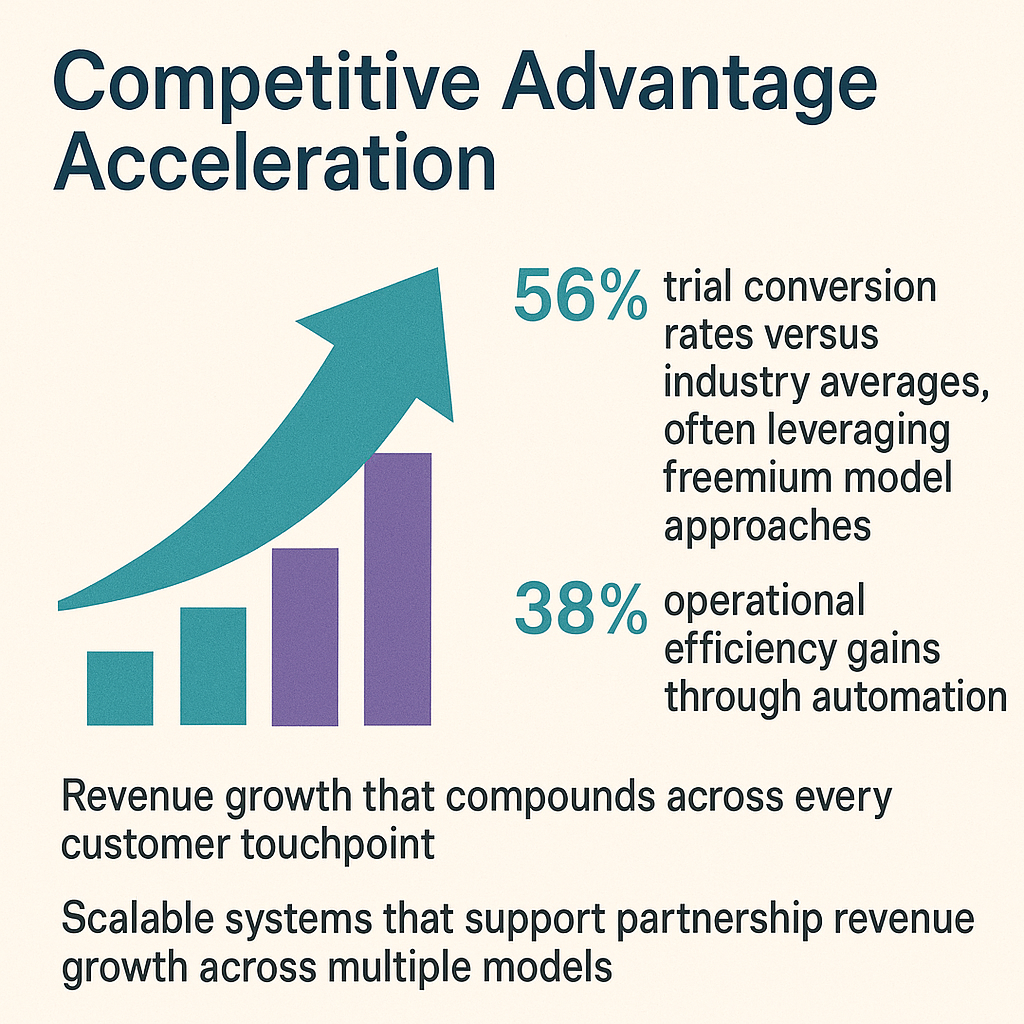5
-min read

The numbers don't lie: you're witnessing the most significant transformation in B2B software monetization since the birth of SaaS itself.
While everyone talks about AI's impact on products, the data reveals its most dramatic effect may be on operational efficiency. Companies under $25M annual recurring revenue with high AI adoption run GTM organizations with just 13 full-time employees versus 21 for traditional counterparts, providing a 38% reduction in headcount while maintaining or improving performance.
ICONIQ's comprehensive 2025 study, surveying 205 GTM executives across leading B2B companies, reveals that the market is splitting into two distinct categories. The performance gaps are widening at an unprecedented pace.
This efficiency isn't coming from staff cuts but from intelligent automation of core monetization processes that previously required manual intervention. As generative AI continues evolving, companies gain traction by automating routine tasks while allowing users to focus on strategic initiatives.# B2B Software Monetization in 2025: What Industry Data Reveals About Performance Gaps
Understanding software licensing models becomes crucial for driving sustainable revenue growth. For product leaders managing software portfolios, understanding these shifts isn't just informative—it's essential for competitive survival in today's evolving landscape.

The data reveals a stark reality: while overall SaaS growth has remained flat for two years, companies with sophisticated monetization strategies achieve dramatically different outcomes. AI-native companies convert free trials to paid customers at 56% versus just 32% for traditional SaaS companies at the $100M+ ARR level. This 24-percentage-point chasm represents the difference between thriving and merely surviving.
Companies with high AI adoption across their GTM organizations systematically outperform across every metric that matters. The performance advantages are clear and measurable:
This performance gap reveals fundamental differences in how these companies approach customer acquisition and monetization strategy. The most striking advantage remains trial conversion rates, where AI-native companies achieve success that traditional approaches simply can't match in today's competitive landscape.
The 24-percentage-point gap in trial conversion rates isn't just a statistical anomaly. It represents a systematic approach to understanding and acting on customer behavior that traditional companies miss entirely. High-performing companies have cracked the code on three critical elements that drive superior trial conversions and customer retention.
The highest-converting companies don't wait until the end of a trial period to understand conversion likelihood. They track specific usage patterns that correlate with buying intent. These companies excel at data monetization, transforming raw data into actionable insights. The behavioral signals include several key indicators:
When prospects exhibit these behavioral signals, sales teams receive immediate alerts enabling timely intervention. This data monetization approach transforms raw usage information into actionable sales intelligence that directly impacts revenue growth.
AI-native companies architect their trial experiences to deliver measurable value within days, not weeks. They identify the minimum viable experience that demonstrates ROI and build guided onboarding flows, ensuring prospects reach value milestones quickly. Many implement a freemium model to allow users initial access while gating premium features behind paid tiers.
This isn't about feature tours but about creating "aha moments" where prospects can immediately quantify business impact. Your goal should be to help customers receive tangible value before they have time to question the investment or evaluate alternatives. Implementing effective trial conversion strategies becomes essential for maximizing revenue from your trial programs.
Rather than relying on scheduled check-ins, high-performing companies use usage data to trigger contextual outreach. The most effective engagement triggers focus on specific user behaviors:
This transforms generic follow-ups into valuable consultative conversations. Your team gains insights into customer behavior patterns that drive meaningful engagement rather than superficial touchpoints.
Companies achieving 56% trial conversion rates require significant infrastructure investments, but the returns are measurable and substantial. You need real-time usage tracking, behavioral analytics, automated alert systems, and seamless integration between trial environments and customer intelligence platforms.
The investment pays immediate dividends: moving from 32% to 56% trial conversion rates can more than double new customer acquisition with the same trial volume. Superior trial conversion doesn't just impact customer acquisition—it creates a data advantage that compounds over time.

Companies with higher conversion rates gather more behavioral data from successful conversions, enabling continuous refinement of predictive models and trial experience optimization. This creates a virtuous cycle where conversion advantages accelerate rather than plateau, providing valuable insights that enhance customer retention over time.
Your data becomes increasingly valuable as your customer base grows and engagement patterns become clearer. The performance scorecard tells a compelling story across multiple dimensions:
These metrics demonstrate that infrastructure investments in customer intelligence create compound returns across the entire revenue operation.
One of the clearest signals in the data shows rapid adoption of hybrid pricing models among successful companies. Among AI-native companies, 37% now use hybrid pricing that blends subscription and usage components, compared to 30% of traditional SaaS companies. These aren't experimental pilots—companies using hybrid pricing models report balanced revenue splits across their pricing components.
The revenue composition tells a revealing story about modern monetization strategy. Companies successfully implementing hybrid pricing models see revenue distributed across multiple streams:
This shift reflects a fundamental truth that forward-thinking product leaders have recognized: different customers have varying customer preferences, and rigid pricing models leave significant money on the table. Businesses can no longer solely rely on single pricing models when market demand varies significantly across customer segments.
Companies can now offer platform fees combined with usage-based pricing credits, gating access to premium features while aligning pricing with natural consumption patterns. This approach proves effective for AI products where usage varies significantly across customer segments. Modern hybrid licensing models enable companies to align pricing with customer value realization.
Your monetization strategy should reflect how customers actually consume value, not just how you prefer to package it. The most successful implementations provide flexibility while maintaining predictable revenue streams that support business planning and growth initiatives. Smart businesses structure hybrid pricing to maximize revenue potential while ensuring customer satisfaction.
Implementing sophisticated pricing models isn't just a strategic decision but a technical challenge requiring purpose-built infrastructure. You need granular visibility into how customers consume your software across multiple dimensions simultaneously. Modern systems must track feature usage, API calls, data processing volumes, user interactions, and outcome achievements in real-time while attributing them to correct billing components. This capability proves essential whether serving enterprise clients or growing user bases across mobile apps and web platforms.
This isn't just about collecting data but about transforming usage events into billable items automatically while maintaining accuracy and auditability. Your infrastructure should seamlessly connect customer behavior to revenue recognition without manual intervention, enabling effective data monetization across all customer touchpoints.
When customers have subscription access to core features plus usage-based consumption of advanced capabilities, your systems must handle complex entitlement calculations in real-time. Consider a typical enterprise scenario where customers might have:
The entitlement system must process these calculations continuously while providing immediate feedback to both customers and internal teams about current usage status. This eliminates confusion about access rights and prevents unexpected billing surprises that damage customer relationships. Such systems enable businesses to support multiple models within a single platform while maintaining pricing transparency.
Hybrid pricing models create accounting complexity requiring sophisticated billing infrastructure. You need systems handling multiple billing cycles, proration calculations, mid-cycle changes, and complex revenue recognition rules across different pricing components. Manual processing becomes impossible at scale, making automation essential for financial stability.
The most successful hybrid pricing implementations provide customers with real-time visibility into usage and costs across all pricing dimensions. This requires customer portals with comprehensive functionality that provide customers receive immediate access to:
Customers need these self-service capabilities to understand bills without requiring support intervention. Pricing transparency builds trust and reduces friction in the buying process, whether dealing with free users exploring basic features or enterprise clients managing complex deployments.
Hybrid pricing models also require seamless data flow between your product, usage tracking systems, billing platforms, CRM, customer success tools, and revenue recognition systems. Each component must receive accurate, timely data while maintaining consistency across the entire tech stack.
API reliability and data synchronization become business-critical rather than technical nice-to-haves. Your integration strategy should eliminate data silos that prevent unified customer intelligence and create operational inefficiencies.
While everyone talks about AI's impact on products, the data reveals its most dramatic effect may be on operational efficiency. Companies under $25M ARR with high AI adoption run GTM organizations with just 13 full-time employees versus 21 for traditional counterparts, which is a 38% reduction in headcount while maintaining or improving performance.
This efficiency isn't coming from staff cuts, but instead it's coming from intelligent automation of core monetization processes. The most impactful automation areas include several key operational functions:
These automated systems eliminate manual approvals and provisioning, allowing customers to access software immediately upon purchase. AI-powered customer onboarding reduces time-to-value and support ticket volume significantly. Whether managing a new app launch or scaling existing platforms, automation provides the foundation for sustainable growth.
The result is clear: teams can focus on high-value activities that drive revenue growth rather than getting bogged down in operational tasks that don't scale effectively. Your ability to automate routine processes directly determines your capacity for growth without proportional cost increases.
Real-time monitoring identifies churn risks before they impact revenue, enabling proactive intervention that preserves customer relationships. This automation creates competitive advantages that compound over time as your customer base expands. Understanding how to leverage usage analytics transforms operational data into strategic revenue opportunities, whether managing a standalone product or multiple revenue streams.
The performance advantages of sophisticated monetization strategies compound across the entire sales funnel, creating a meaningful competitive edge in today's challenging market. High AI adopters demonstrate superior conversion rates at every stage of the customer acquisition process.
The conversion improvements are consistent across all funnel stages:
These improvements reflect a deeper strategic truth: when prospects can immediately understand ROI through transparent usage tracking and flexible trial configurations, buying decisions become obvious rather than theoretical.
Companies that demonstrate value in real-time, often through sophisticated licensing and analytics platforms, close deals faster, even in increasingly challenging market conditions. Your ability to show concrete value during trials directly correlates with conversion success.
While top-of-funnel metrics remain stable across the industry, conversion rates deeper in the sales funnel have declined significantly. SQL to Closed-Won rates are down 5-6 percentage points year-over-year, and Demo to Closed-Won rates have dropped 4-9 percentage points across all segments.
Companies with advanced monetization capabilities buck these trends through immediate value demonstration and pricing transparency. This creates sustainable competitive advantages that become more pronounced as market conditions tighten.
The data reveals a clear maturation pattern in monetization strategies as companies scale. Companies with $250M+ annual recurring revenue derive 29% of their revenue from channel partnerships, nearly double the rate of companies under $25M. This isn't just about partnerships—it's about having infrastructure to support complex, multi-tiered monetization strategies.
The progression shows how successful companies evolve their partnership approach as they grow:
This progression demonstrates that partnership revenue becomes increasingly important as companies mature and expand their market reach.
Larger companies can't afford rigid licensing models because they need systems that can accommodate partner requirements. These systems must handle multiple pricing tiers across different customer segments, channel partner requirements, and margin structures, geographic variations in packaging and compliance, integration with existing CRM, ERP, and billing systems, and real-time usage tracking across diverse customer bases.
Companies that invest early in flexible licensing infrastructure position themselves better to scale these complex go-to-market motions. Your choice of monetization platform today determines your partnership revenue potential as you grow and need to support multiple models across different market segments.
Perhaps the most telling indicator of market direction is how companies allocate their budgets for growth initiatives. High-growth companies plan 94% increases in AI spend for GTM use cases—nearly doubling their investment in monetization technology and processes.
The investment priorities reveal a clear focus on monetization efficiency across several key areas:
These aren't experimental budgets but strategic bets on fundamentally different approaches to capturing and maximizing customer value. Companies that identify prospects likely to convert, personalize pricing and packaging, and optimize renewal strategies through data-driven insights build sustainable competitive advantages.
The ICONIQ data also reveals fascinating differences in how companies organize GTM teams based on their monetization sophistication. AI-native companies allocate more resources to post-sales teams (31% vs 27%), reflecting the technical complexity of implementing and driving the adoption of advanced products.
Your investment in customer intelligence infrastructure today determines whether you'll lead or follow in tomorrow's market dynamics. Your organizational design should align with how customers actually experience value from your software, not just how you prefer to structure internal teams.
The data makes clear that you're not experiencing a temporary market fluctuation, but in the early stages of a fundamental transformation of how B2B software creates and captures value. The mid-stage breakout in the data proves particularly encouraging for companies making strategic investments in advanced monetization capabilities.
Companies in the $25M-$100M ARR range saw their top quartile growth rates jump from 78% to 93% and the only segment showing meaningful improvement. This suggests that companies reaching this inflection point with sophisticated monetization strategies are positioned to break through traditional growth plateaus.

Your ability to scale advanced pricing models determines whether you'll join this high-performance tier. Companies that adapt their monetization strategies to this new reality will thrive, while those that don't risk being left behind by competitors who can offer more flexible approaches.
The acceleration is just beginning, and the performance gaps between leaders and laggards will only widen as more sophisticated tools and strategies become available. Smart engineering teams focus on building infrastructure that can stay ahead of market changes while maximizing monetization potential. Those that choose wisely and act quickly on these insights will join the ranks of companies achieving superior performance across all metrics:
These advantages compound over time, creating sustainable differentiation in increasingly competitive markets. Companies that choose wisely in their infrastructure investments today gain insights that enable long-term success.
The ICONIQ findings point to several critical imperatives for product leaders managing software portfolios in 2025 and beyond. The era of one-size-fits-all pricing is definitely over, and your monetization strategy needs to accommodate different customer preferences, usage patterns, and buying behaviors within a unified platform.
You can't solely rely on single pricing models when customers demand options that match their consumption patterns and budget constraints. Manual licensing processes that worked for smaller customer bases become impossible to scale efficiently.
Automation isn't just about reducing costs—it's about enabling revenue growth without proportional increases in operational overhead. Your engineering teams should prioritize building systems that handle complexity automatically rather than requiring manual intervention for routine monetization tasks.
In an environment where sales cycles extend across the board, companies that demonstrate immediate, measurable value during trials and proofs of concept gain significant competitive advantages. The key requirements include:
Infrastructure choices today determine your ability to compete effectively as market conditions continue evolving and customer expectations increase. Companies that fail to invest in scalable solutions often find themselves unable to capture their full revenue potential as they grow.
The ICONIQ findings reveal that the highest-performing companies have made a fundamental shift from reactive monetization to proactive revenue optimization powered by real-time customer intelligence. This isn't just about having better tools—it's about fundamentally redesigning how organizations capture, analyze, and act on customer behavior data.
Revenue teams need systems that can provide comprehensive customer intelligence across the entire lifecycle. The essential capabilities include several critical functions:
Companies achieving superior performance have solved this customer intelligence challenge by transforming usage data into precise revenue actions that drive measurable business outcomes.
Modern revenue teams need platforms that can monitor usage patterns indicating expansion opportunities, automate customer journey tracking from trial through renewal, integrate with existing monetization systems for faster delivery, and provide predictive analytics that turn usage data into accurate revenue forecasting.
This isn't about replacing existing systems but about adding the customer intelligence layer that transforms reactive processes into proactive revenue generation strategies. The most sophisticated revenue teams now use platforms covering the complete customer lifecycle, giving every team member the context they need for optimization.
The performance gaps revealed in the ICONIQ study will only widen as more companies implement sophisticated customer intelligence systems. The question isn't whether your organization needs better visibility into customer behavior and buying signals, but how quickly you can implement systems that enable proactive revenue optimization.
Companies already achieving 56% trial conversion rates and 20-week sales cycles have made their choice. They've invested in customer intelligence infrastructure that enables them to act on data rather than just collect it.
The most sophisticated revenue teams now use platforms covering the complete customer lifecycle from initial trial through ongoing expansion, giving every team member the context they need to optimize their specific part of the revenue process. This requires organizational changes that support data-driven decision making:
These organizational advantages create efficiency gains that compound over time, enabling sustainable competitive differentiation.
As the ICONIQ data demonstrates, performance advantages of sophisticated monetization strategies compound across every metric that matters. Organizations that identify opportunities earlier, prevent churn proactively, and optimize customer journeys based on real usage data will continue to pull ahead.
The window for strategic action is narrowing, and companies winning in 2025 have already recognized that fundamental organizational redesign isn't optional but the price of admission to achieving performance levels that separate market leaders from the rest. The infrastructure, processes, and customer intelligence capabilities that separate high performers aren't secrets but investments in systems that transform how revenue teams understand and optimize customer relationships.
The transformation of B2B software monetization represents both an unprecedented opportunity and an urgent imperative for companies seeking sustainable growth. The data shows clear patterns: companies embracing flexible pricing strategies, investing in customer intelligence infrastructure, and redesigning their organizations around data-driven revenue optimization consistently outperform traditional approaches.
Your success in this transformation depends on making strategic choices about infrastructure, organizational design, and customer intelligence capabilities. The companies achieving superior performance have made deliberate investments in systems that turn customer behavior into a competitive advantage. Whether you're developing mobile apps, managing enterprise software, or creating new digital products, understanding these patterns provides valuable insights for growth.
The future belongs to organizations that can seamlessly blend subscription models, usage-based pricing, and outcome-based pricing within unified platforms. The most critical success factors include:
Those who choose wisely and act quickly on these insights will lead the market, while those who delay risk being left behind by competitors who recognize that waiting is no longer a viable strategy. Smart businesses understand that AI continues advancing, making early investment in the proper infrastructure a prime example of strategic thinking.
The data makes it clear: software monetization 2025 will be defined by companies that can adapt quickly, invest strategically, and execute effectively on customer intelligence infrastructure that transforms data into sustainable competitive advantages across every aspect of the customer lifecycle.
Ready to join the companies achieving 56% trial conversion rates?
Zengain provides the real-time customer intelligence that bridges the performance gap between market leaders and the rest. Stop guessing which prospects will convert and start knowing exactly when to engage for maximum impact.
Discover how Zengain transforms your trial data into actionable insights that drive revenue growth, reduce churn, and optimize your entire customer lifecycle. Whether you're managing mobile apps with in-app purchases, implementing freemium model approaches, or scaling enterprise solutions, our platform provides the key takeaways you need for success.